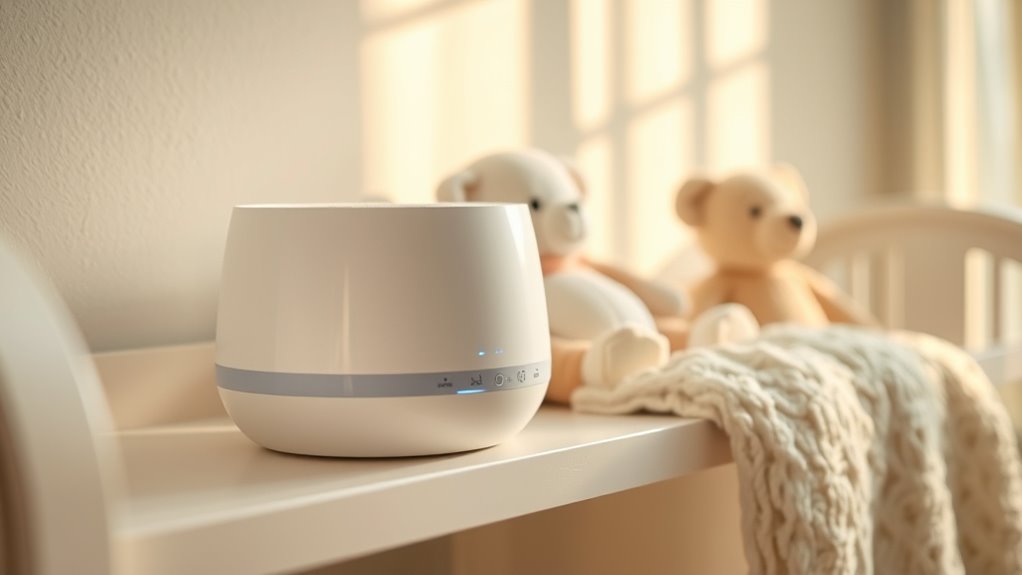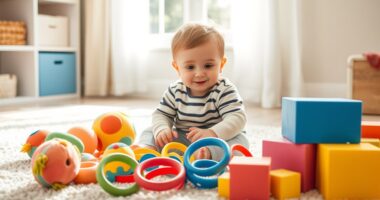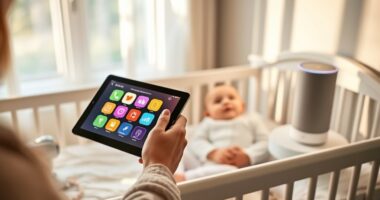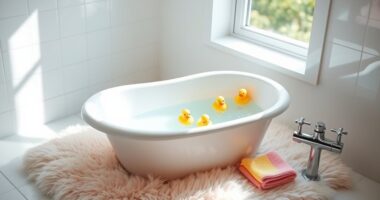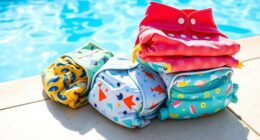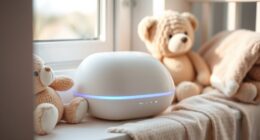To guarantee your baby’s hearing stays safe, keep the noise level from white noise machines below 50 decibels, similar to a soft conversation or rain. Use a decibel meter app or check your device’s settings to monitor volume. Position the machine a few feet away from the crib and avoid loud, close sounds. Proper placement and careful adjustment help protect your baby’s hearing while providing soothing sound therapy. Learn more about maintaining safe noise levels here.
Key Takeaways
- Keep sound levels below 50 decibels to protect your baby’s hearing health.
- Use a decibel meter app to measure and monitor the noise output of devices.
- Place white noise machines at least a few feet away from the crib to prevent excessive exposure.
- Choose devices with built-in volume controls and safety features for safe operation.
- Regularly review and adjust volume settings based on your baby’s responses and fussing cues.
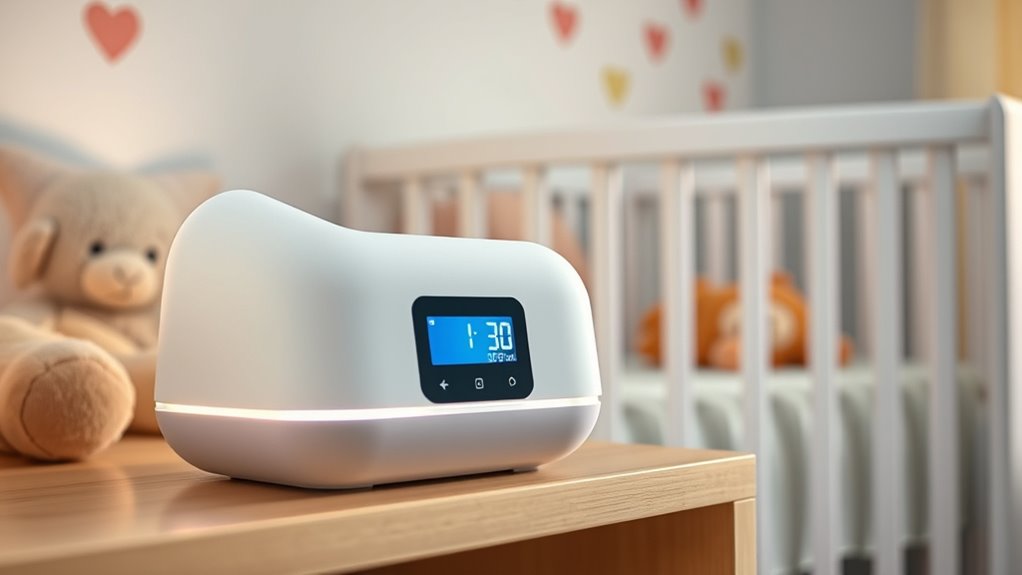
White noise machines can be effective tools for helping your baby fall asleep and stay asleep, but it’s important to use them safely. One key aspect of safe usage is understanding noise level limits. Excessively loud sounds can harm your baby’s delicate hearing, so it’s vital to follow sound therapy guidelines and safety standards when selecting and operating these devices. Many manufacturers design white noise machines with safety standards in mind, but it’s still your responsibility to make certain you’re using them correctly.
Sound therapy relies on consistent, soothing background noise, but volume matters. The goal is to create a calming environment without exposing your baby to potentially damaging sound levels. Experts recommend keeping the volume below 50 decibels, roughly equivalent to a soft conversation or gentle rain. Some simple tools, like a decibel meter app, can help you measure the noise output from your device. If the sound seems loud or if you notice your baby fussing or waking, it’s a sign to turn down the volume. Remember, even a seemingly quiet noise can be harmful if it’s persistent and close to the ear.
Many white noise machines come with built-in volume controls and preset safety features designed to keep sound levels within safe limits. It’s wise to double-check that these features are active and functioning properly. Also, position the machine at a safe distance—at least a few feet away from your baby’s crib—to prevent direct exposure to loud sounds. The goal is to provide a soothing background that masks household noises without overexposing your little one to loud sound therapy. Proper device placement can significantly influence the safety and effectiveness of sound therapy. Additionally, choosing devices that have sound level monitoring features can help ensure you stay within safe limits.
Ensure your white noise machine has active safety features and is placed at least a few feet from your baby’s crib.
Additionally, consider the environment where you place the device. Hard surfaces tend to bounce sound, possibly amplifying it, so placing the machine on a stable, elevated surface is recommended. Make sure the machine is turned off when not in use, especially if your baby is sleeping soundly, to avoid unnecessary exposure. Regularly review the device’s settings and your baby’s response to the sound, adjusting volume as needed. Maintaining an awareness of sound level guidelines and regulatory standards can further help you protect your baby’s hearing health long-term. Moreover, understanding the angel number signals related to love and relationships can guide your emotional well-being and support your baby’s overall development.
In essence, understanding and respecting noise level limits isn’t just about following guidelines; it’s about prioritizing your baby’s safety. Sound therapy can be incredibly beneficial when used correctly, but it requires vigilance and proper device management. Always use white noise machines that adhere to safety standards and stay alert to your baby’s cues. By doing so, you ensure that your little one benefits from soothing sound environments without risking hearing damage, creating a safer and more restful sleep environment for everyone.
Frequently Asked Questions
Are There Specific Noise Level Standards for Different Age Groups?
You might wonder if there are age-specific standards for noise levels. Generally, regional regulations set guidelines to protect children’s hearing at different stages. These standards vary, ensuring infants, toddlers, and older kids are safe from excessive noise exposure. As you choose a white noise machine, look for devices that adhere to these age-specific standards and regional regulations, so your child stays safe while enjoying soothing sounds.
How Do Noise Levels Affect a Baby’s Hearing Development?
Imagine the delicate start of your baby’s hearing sensitivity shaping their future. Excessively loud noise can harm their ears, potentially delaying key developmental milestones. You hold the power to protect their hearing by controlling sound levels, ensuring they’re neither overwhelmed nor deprived. When you maintain safe noise levels, you foster healthy auditory development, nurturing their ability to explore, learn, and connect with the world around them.
Can White Noise Levels Cause Long-Term Hearing Damage?
If you’re worried about white noise causing long-term hearing damage, it’s important to understand noise exposure risks. Excessive noise levels can lead to hearing loss over time, especially if your baby is exposed frequently or at high volumes. To protect their hearing, keep the volume at safe levels and limit exposure duration. Proper noise management helps prevent potential long-term damage and supports healthy hearing development.
Do Noise Level Limits Vary by Country or Region?
You might wonder if noise level limits for white noise machines vary by country or region. In fact, regional regulations often set different standards based on noise measurement practices and safety guidelines. These regulations aim to safeguard hearing health by establishing maximum volume levels. It’s essential to check local laws and manufacturer recommendations to guarantee safe usage, especially since noise measurement methods can influence the permissible limits in your area.
How Often Should White Noise Machines Be Tested for Compliance?
Think of your white noise machine as a trusted lighthouse keeper. To guarantee it shines brightly and safely, you should follow a regular maintenance schedule and testing frequency. Check it at least every few months, especially if used frequently, to confirm it stays within safe noise levels. Regular testing helps catch any issues early, ensuring your baby’s environment remains safe and soothing.
Conclusion
Understanding noise level limits for baby white noise machines is essential for your little one’s safety and sleep quality. Did you know that over 50% of parents underestimate how loud their machines are? Keeping sound levels below 50 decibels can help prevent hearing damage and promote healthier sleep. By choosing machines within recommended limits, you guarantee a safe environment that supports your baby’s development while giving you peace of mind.
